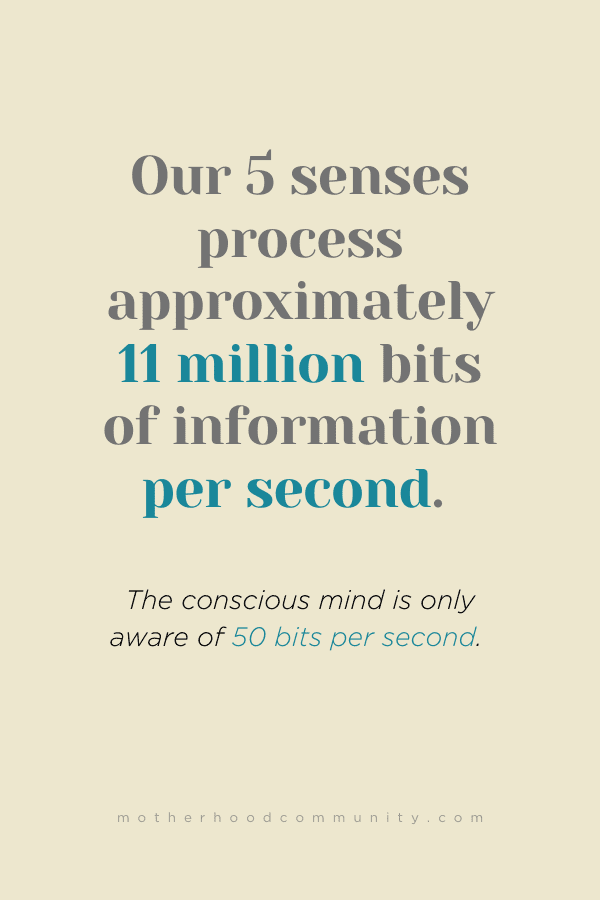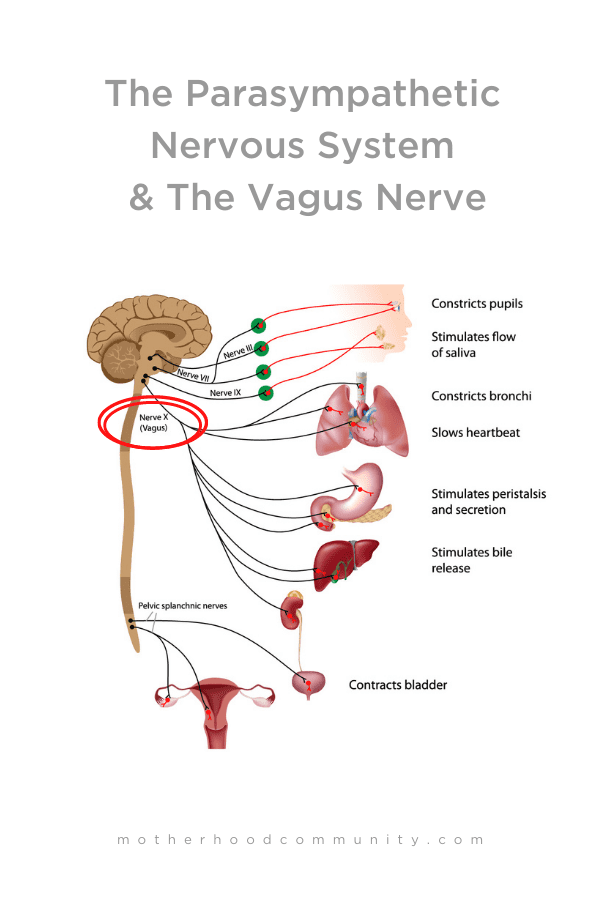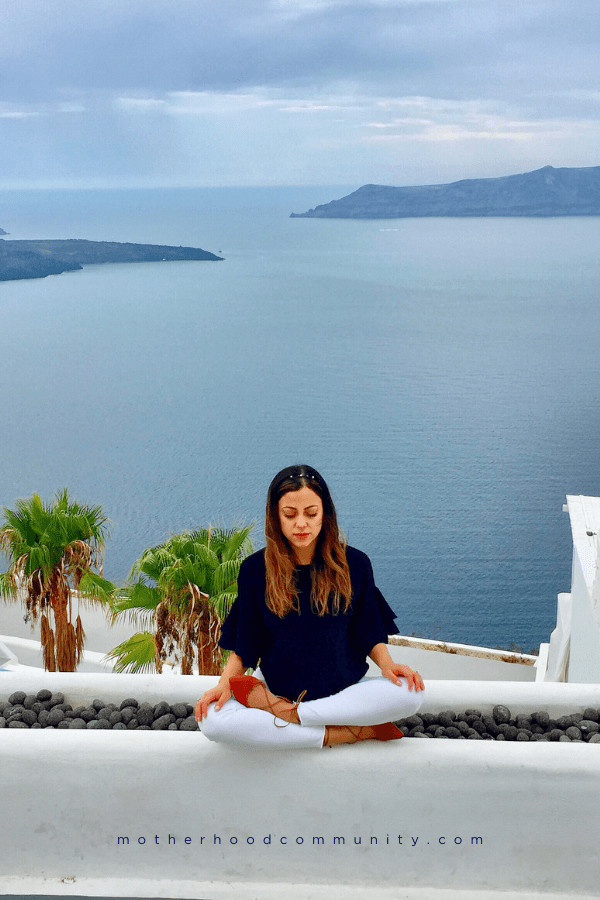Maybe the most important teaching is to lighten up and relax.
– Pema Chodron, Buddhist Monk & Author
Most of us know we need to relax more, but learning to chillax on a regular basis isn’t so easy.
Especially if you’re juggling multiple projects, racing to meet important deadlines, or raising rambunctious babies.
We might turn to things like wine, weed, and food to help us get there, but this isn’t the most sustainable option sometimes.
Whether you’re someone who’s constantly tackling your to-do list or are a mama on the go – learning to stop, pause, and reset can be an invaluable self-care tactic.
You don’t need to go off to a retreat or even leave your house, though.
All you need are 3 simple yet proven yoga practices that can help you soothe and calm your body, mind, and nervous system.
Keep reading to learn three surprising ways yoga can help recharge your energy so you keep showing up for your family and yourself.
In yoga, we call energy prana (aka chi, vital force).
If prana flows through your body freely and without blockage you’ll likely experience higher levels of thinking, feeling, and being.
If prana can’t flow or is blocked then it’ll be harder to reach those higher states and instead you might become stuck in survival, stress, and burnout.

Your body is wise and intelligent and knows what to do to keep this balanced flow of energy running through your entire nervous system and body.
Let’s take a quick dive into how your nervous system works to help you stress less and chillax more…
Your Central Nervous System & How You Perceive Your World
The crowning achievement of your body is the Central Nervous System (CNS) which is comprised of your brain and spinal cord.
Think of it as a central command station that processes over 11 million bits of information per second thanks to its 86 billion neurons (brain cells).

At any given moment your nervous system is hard at work sending and receiving signals of danger or safety from different parts of your body.
Your Peripheral Nervous System (PNS) sends most of this information from your extremities to your CNS for processing.
A branch of the PNS is called the Autonomic Nervous System (ANS) which can be viewed as the “automatic” nervous system.
Your ANS helps you process what’s going on in your outer world 24/7 non-stop without you having to lift a conscious finger.
It helps you scan your environment for potential threats.
The problem today is that it’s on constant overdrive because we’re increasingly more and more chronically stressed out, overwhelmed, overstimulated, and fatigued.
This leads to an ANS imbalance – an overactive stress response and an underactive relaxation response.
ANS imbalanced can lead to trouble sleeping, trouble managing emotions, metabolism problems, trouble thinking clearly, and even chronic illness.
That’s why it is so very important to know how to quiet down the stress response while activating the relaxation response…
A Quick Overview of the 2 Branches of Your ANS:
Your ANS oversees many of your body’s vital functions and controls the activities of target organs, smooth muscle, and glands.
Your ANS has two branches that act much like yin-yang.
They are complementary opposites.
If one is activated, the other is suppressed and vice versa.
They are called the sympathetic nervous system (SNS) and the parasympathetic nervous system (PSNS).
The SNS, which acts like the gas pedal, revs up our body and mind whilst activating the fight-or-flight response.
This is the branch that reacts to stressful situations by arousing a defensive and protective mode.
People with insomnia and anxiety tend to have an overactive SNS.
The Parasympathetic system is your body’s ultimate chillax mechanism that acts as the brake pedal.
The PSNS oversees the body’s relaxation response as well as a healing response.
People with insomnia and anxiety benefit greatly from learning to consciously invoke this branch in order to rebalance the entire nervous system.
Like night and day or the sun and the moon the SNS and PSNS work in opposing ways:
Sympathetic Stimulation:
– Dilates pupils
– Inhibits salivary glands
– Increases heart rate
– Increases blood pressure
– Increases breath rate
– Inhibits digestion by restricting intestinal movement and gastric secretions
– Raises blood sugar by stimulating glucose production
– Stimulates the secretion of stress hormones like adrenaline
– Blood vessels dilate in skeletal muscles in preparation for “fight or flight”
– Sweat glands are activated
– Inhibits bladder contraction impacting urination
– Inhibits defecation
– Inhibits sexual arousal
– Inhibits the lacrimal gland
Parasympathetic Stimulation:
– Constricts pupils
– Stimulates the flow of saliva
– Decreases heart rate
– Decreases blood pressure
– Decreases breath rate
– Stimulates digestion by enabling intestinal movement and gastric secretions
– Balances blood sugar levels
– Stimulates the secretion of relaxation hormones such as acetylcholine
– Blood vessels in skeletal muscles constrict
– Sweat glands relax
– Contracts the bladder stimulating urination
– Stimulates defecation
– Stimulates sexual arousal
– Stimulates the lacrimal gland and causes tearing
Parasympathetic nerves are found at the base of the head (brain stem) and also at the base of the spine.
Sympathetic nerve fibers are spinal nerves that run along the middle spine:
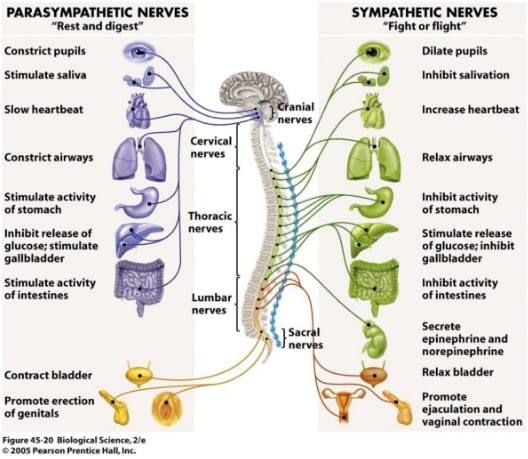
Ganglia refers to a cluster of nerve cell bodies.
Parasympathetic ganglia start at the base of the brain stem through cranial nerves such as the glossopharyngeal nerve (aka Cranial Nerve IX), and the submandibular ganglion: (1)
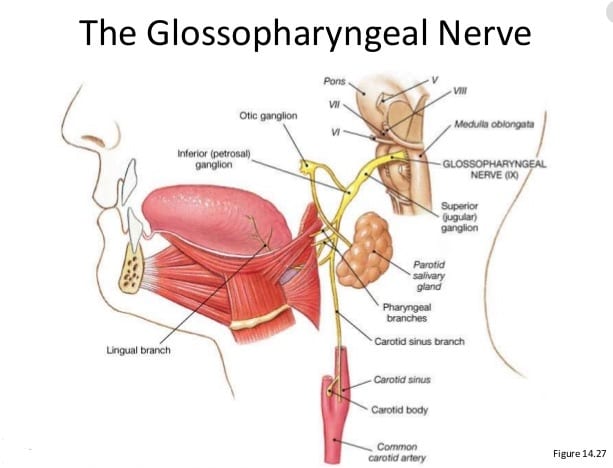
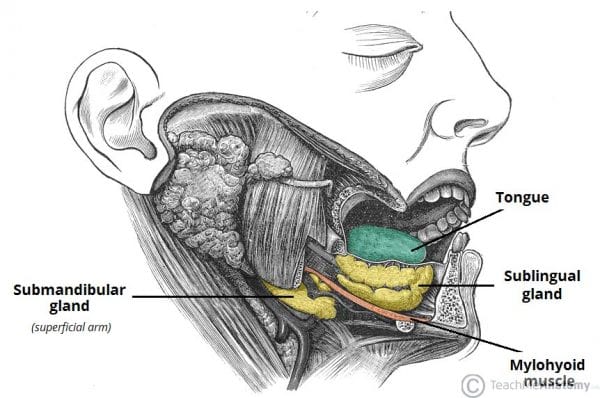
The Vagus Nerve & the Relaxation Response:
The Vagus nerve is the longest, most complex of all parasympathetic fibers.
Known as the tenth cranial nerve, or Cranial Nerve X, the Vagus Nerve runs from the brainstem through the face, esophagus, and neck, to the heart and lungs, down to the abdomen. In the abdomen, the vagus nerve is connected to the viscera and the greater part of the GI tract.
By stimulating the Vagus Nerve we initiate the Relaxation Response and help the body to respond more calmly to stress.
One proven way to stimulate this very important nerve is through intentional, deep, belly breathing.
As Dr. Esther Sternberg, a stress and healing researcher at the Nat’l Institute of Mental Health, explains, the stress response is the gas pedal, and the Vagus nerve is the brake:
“The relaxation response is controlled by another set of nerves — the main nerve being the Vagus nerve.
Think of a car throttling down the highway at 120 miles an hour.
That’s the stress response, and the Vagus nerve is the brake.
When you are stressed, you have your foot on the gas, pedal to the floor.
When you take slow, deep breaths, that is what is engaging the brake.” (2)
Benefits of an Activated (Stimulated) Vagus:
- It plays an anti-inflammatory role in the body. People with chronic anxiety and depression have higher levels of inflammation in the gut and other parts of the body as well as an increased risk of leaky gut, which we’ve seen is linked with chronic inflammation (3)
- Promotes neurogenesis (regeneration and growth of brain cells). One study found that “increasing adult neurogenesis is sufficient to reduce anxiety and depression-related behaviors.” Antidepressants increase neurogenesis, however, neurogenesis via chronic vagal nerve stimulation was found to be “much faster than that induced by antidepressant drugs.” (4) (5)
- It greatly increases BDNF levels in the brain’s hippocampus region. BDNF (brain-derived neurotrophic factor) is a brain chemical that’s like brain fertilizer. It’s thought to play a role in the regulation of stress response and mood disorders. People with anxiety and depression are found to have lower levels of BDNF, especially in the hippocampus. The great news is that the same study that linked chronic vagal nerve stimulation to neurogenesis also found that consistently stimulating the vagus “did induce a robust increase in the expression of BDNF in the hippocampus.” (4)
4 Ways Yoga Can Help Stimulate The Vagus Nerve & Activate The Chillax Mechanism:
Regular elicitation of the Relaxation Response can prevent, and compensate for, the damage incurred by frequent nervous reactions that pulse through our hearts and bodies.
― Herbert Benson, author of ‘The Relaxation Response’
1- Pranayama – Yogic Breathwork

The word ‘pranayama‘ literally translates to ‘regulation of vital force energy.’
Although there are many different pranayama practices and techniques, we’re just going to focus on two elements that studies show quickly increase PSNS activity:
1 – belly breathing
2 – longer exhalations
Quick 2-minute pranayama practice:
1 – Sit comfortably with your spine erect and straight.
2 – Relax the shoulder, neck, and jaw
3 – Close your eyes
4 – Inhale for 4 counts by engaging your lower belly (belly expands outwardly)
5 – Exhale for 6 or 8 counts as your lower belly contracts towards the spine.
6 – Repeat steps 4 and 5 for at least 10 rounds.
For more guidance on how to adopt a simple daily pranayama practice go here.
Remember, you don’t need to dedicate hours to these practices.
Start off with five minutes a day and notice how you feel.
Bonus points for getting your pranayama practice in as the first thing in the day.
This can help set the tone for the rest of your day.
Many people experience higher levels of productivity, mental clarity, and creativity.
Your partner or kids may notice you’re less reactive and more receptive.
2- Mantra Chanting

Believe it or not, chanting helps calm the emotional brain too.
One study using functional Magnetic Resonance Imaging (fMRI) to scan the brains of subjects chanting found that it also significantly deactivates the amygdala, the brain’s fear center which is closely interconnected with the stress response. (6)
The vibrations from the vocalizations of chanting are also believed to stimulate the Vagus Nerve because its nerve fibers travel down the middle ear and through the neck. (7)
If chanting a simple mantra like Om or So Hum out loud feels a little uncomfortable try humming instead.
You’ll get the same vibratory effect on your Vagus nerve. 🙂
3- Meditation (Dhyana)
Meditation, which in Yoga is called Dhyana, is an ancient practice that only in the last few decades has garnered the attention of the scientific and medical community.
There are many different kinds of meditation – mantra meditation, mindfulness meditation, loving-kindness meditation, etc.
Each style offers multiple benefits such as helping us hit the reset button in order to relax more.
4- Asana (Physical Poses)
Moving the body mindfully, deliberately, and gracefully in a sequence of postures can help to stimulate nervous system networks.
Studies also find that the consistent practice of yoga asana can help to enhance ANS (autonomic nervous system) functions such as heart rate and blood pressure. (8)
One study found that the practice of Iyengar style yoga (which uses many props such as chairs and ropes) increased parasympathetic activity while also increasing Heart-Rate Variability (HRV) which is a known indicator of health, longevity, and emotional regulation. (9)
Try this simple restorative pose:
Legs Up The Wall (Viparita Karani)
Lay on your back either on your bed or on a mat and place both legs up the wall.
Remain in this position for at least 5 minutes as you breathe slowly and deeply.
Closing your eyes can help you relax further.
This pose is also a great option for good blood flow and balanced blood pressure.
REFERENCES
:
(1) Autonomic nervous system. In: Power I, Kam P, eds. Principles of Physiology for the Anaesthetist, 2nd Edn. New York: Oxford University Press, 2008; 57–61
(2) http://www.npr.org/2010/12/06/131734718/just-breathe-body-has-a-built-in-stress-reliever
(3) https://www.ncbi.nlm.nih.gov/pmc/articles/PMC1430829/
(4) https://www.ncbi.nlm.nih.gov/pmc/articles/PMC2879889/
(5) https://www.ncbi.nlm.nih.gov/pubmed/25833129
(6) https://www.ncbi.nlm.nih.gov/pmc/articles/PMC3099099/
(7) https://www.youtube.com/watch?v=VAL-MMYptQc
(8) https://www.ncbi.nlm.nih.gov/pmc/articles/PMC4097908/
(9) https://www.ncbi.nlm.nih.gov/pmc/articles/PMC2176143/



